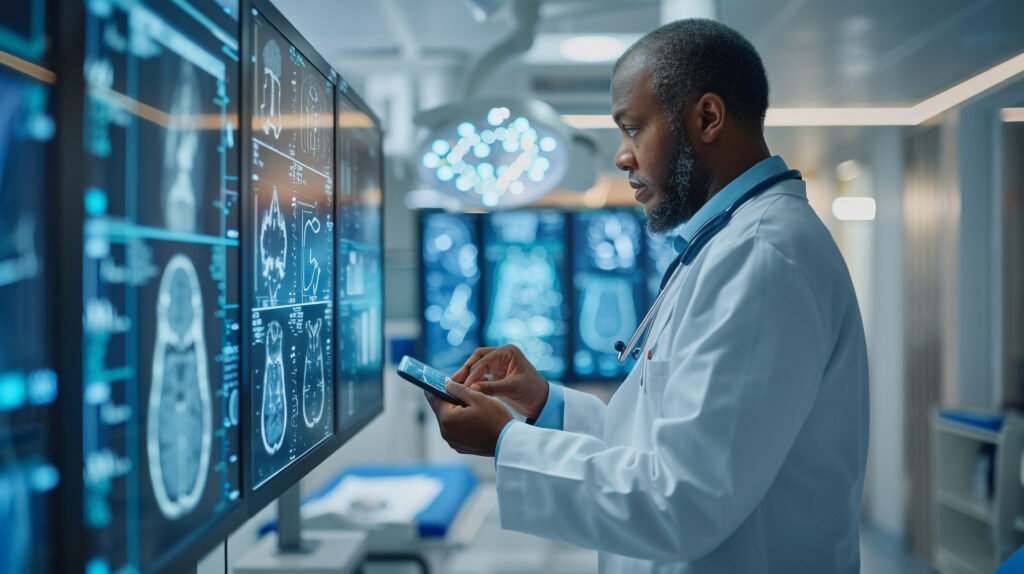AI and Digital Health in 2025: Revolutionising Global Healthcare
In the rapidly evolving landscape of modern medicine, Artificial Intelligence (AI) and Digital Health have emerged as transformative forces. Together, they are reshaping how healthcare is delivered, accessed, and experienced—ushering in a new era of precision, efficiency, and personalisation. But with innovation comes complexity. This article explores what AI and digital health truly mean, how they are implemented, and the benefits and challenges they bring to the global healthcare ecosystem.
What Is AI in Healthcare?
AI in healthcare refers to the use of machine learning algorithms, natural language processing, computer vision, and other intelligent technologies to simulate human cognition in analysing complex medical data. These systems can:
- Interpret medical images
- Predict disease progression
- Automate administrative tasks
- Personalise treatment plans
AI doesn’t replace doctors—it augments their capabilities, enabling faster, more accurate decisions.
What Is Digital Health?
Digital health is a broader umbrella that includes:
- Telemedicine
- Wearable health devices
- Mobile health apps
- Electronic Health Records (EHRs)
- Remote patient monitoring
- Digital therapeutics
It’s about leveraging technology to improve health outcomes, enhance patient engagement, and streamline healthcare delivery.
How AI and Digital Health Work Together
AI is the engine, and digital health is the vehicle. Here’s how they integrate:
| Digital Health Tool | AI Integration |
| Wearables (e.g., smartwatches) | AI analyses real-time data to detect anomalies like arrhythmias or glucose spikes |
| Telemedicine platforms | AI chatbots triage symptoms and schedule appointments |
| EHR systems | AI extracts insights from unstructured notes and flags high-risk patients |
| Imaging tools | AI detects tumours, fractures, or lesions with high accuracy |
| Virtual assistants | AI-powered bots remind patients to take meds or follow up on care |
Pros of AI and Digital Health
1. Early Detection and Diagnosis
AI can detect diseases like cancer, Alzheimer’s, and diabetic retinopathy earlier than traditional methods, improving survival rates.
2. Personalised Medicine
By analysing genetic, lifestyle, and clinical data, AI helps tailor treatments to individual patients, minimising side effects and maximising efficacy.
3. Remote Monitoring and Access
Digital tools allow patients to receive care from home, which is especially vital in rural or underserved areas.
4. Operational Efficiency
AI automates repetitive tasks like billing, coding, and documentation, reducing physician burnout and administrative costs.
5. Data-Driven Insights
AI can process vast datasets to uncover trends, predict outbreaks, and guide public health strategies.
6. Enhanced Patient Engagement
Apps and wearables empower patients to track their health, adhere to treatments, and communicate with providers in real time.
Cons and Challenges
1. Data Privacy and Security
With sensitive health data flowing through digital systems, cybersecurity threats and breaches are a major concern.
2. Bias and Inequity
AI models trained on non-diverse datasets may perpetuate health disparities, especially among marginalised populations.
3. Regulatory and Ethical Dilemmas
Who is liable if an AI misdiagnoses a patient? How do we ensure transparency and accountability in algorithmic decisions?
4. Overreliance on Technology
There’s a risk of dehumanising care or overlooking clinical intuition in favour of algorithmic outputs.
5. Digital Divide
Not all patients have access to smartphones, the internet, or digital literacy, widening the gap in healthcare access.
Real-World Applications in 2025
- Radiology: AI tools now assist in over 60% of radiology reads in major hospitals.
- Mental Health: Chatbots like Woebot provide CBT-based support for anxiety and depression.
- Chronic Disease Management: Smart insulin pens and AI-powered glucose monitors help diabetics manage their condition more effectively.
- Hospital Logistics: Agentic AI systems optimise bed allocation, surgery scheduling, and inventory management.
Global Impact and Future Outlook
In countries like the UAE, the UK, and India, governments are investing heavily in AI-powered public health infrastructure. Initiatives like Malaffi in Abu Dhabi and Genome India are creating robust datasets for precision medicine.
By 2030, the global AI in healthcare market is projected to exceed $200 billion, with digital health platforms becoming the primary interface for routine care.
Conclusion: A Balanced Future
AI and digital health are not silver bullets, but they are powerful tools. When implemented ethically and inclusively, they can bridge gaps in care, reduce costs, and improve outcomes. The key lies in human-centred design, robust governance, and continuous collaboration between technologists, clinicians, and patients.



